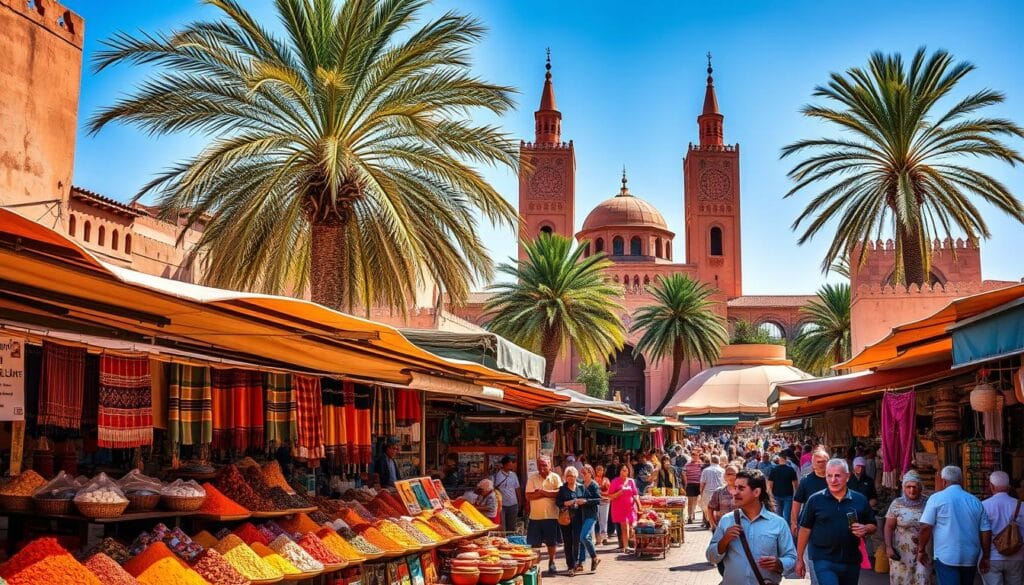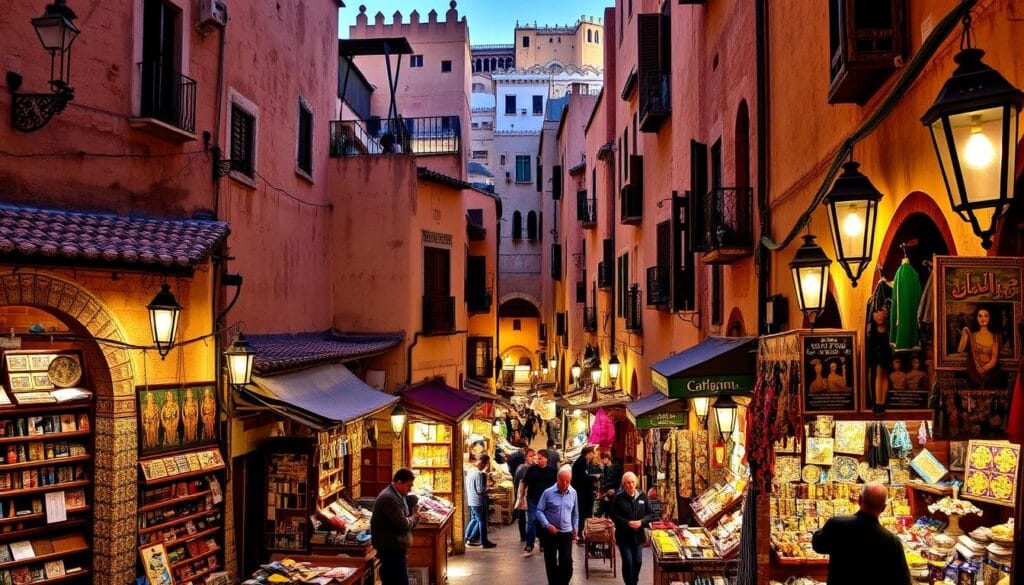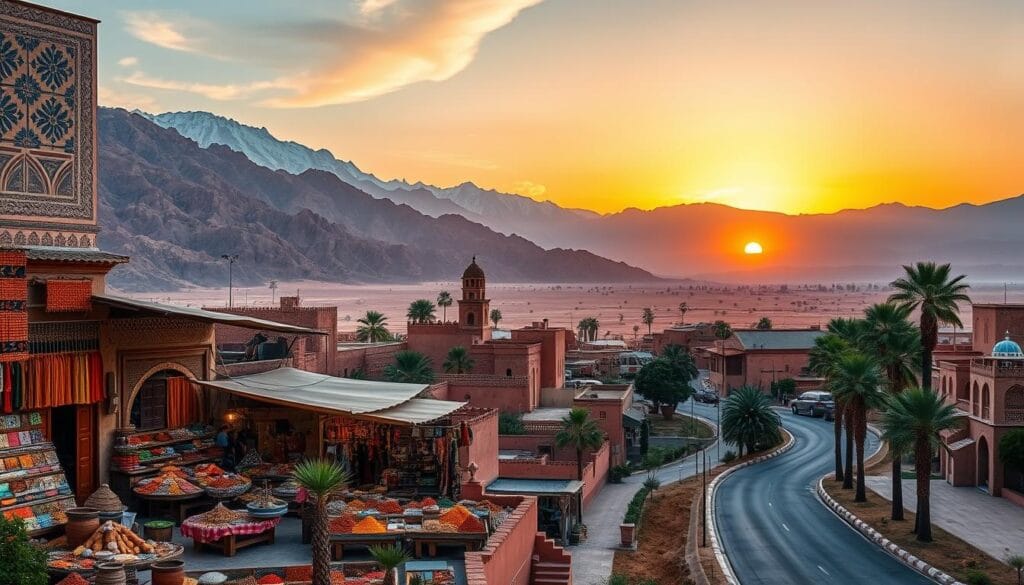Imagine walking through a world where ancient medinas share old stories. Vibrant colors move through the streets. Every part of your 7-day Morocco trip is full of amazing adventures. Morocco is more than a place—it’s a journey that turns travelers into passionate explorers.
This guide will show you the secrets of a land that mixes old traditions with new ways. You’ll see the lively souks of Marrakech and the calm blue streets of Chefchaouen. Your trip through Moroccan cities will be truly magical.
Whether you’re new to travel or have been around, this itinerary offers a deep dive into Morocco. It’s more than just seeing sights. It’s about feeling the country’s heart and sparking your desire to explore.
Table of Contents
🌍 Ready to plan your next adventure? Discover exclusive travel insights and tips with our must-read eBooks – start your journey today! 📖Click here✈️
Understanding Morocco’s Cultural Heritage and Historical Significance
Morocco is a vibrant mix of cultures, blending traditions for centuries. Your trip here will show you a complex world. It’s shaped by Islamic architecture, Berber culture, and colonial history.
The layers of Moroccan culture come from interesting historical meetings. You’ll see ancient mosques with beautiful designs and mountain communities with strong traditions. Morocco offers a unique experience that draws in visitors.
The Legacy of Islamic Architecture
Islamic architecture in Morocco is stunning. Places like the Koutoubia Mosque show amazing design:
- 12th-century religious design influences
- Intricate geometric patterns
- Sophisticated architectural techniques
- Spiritual and aesthetic significance
Influence of Berber Culture
The Berber culture is a key part of Morocco’s identity. Rural traditions and crafts help keep heritage alive:
- Traditional mountain communities
- Unique artisan practices
- Preservation of ancient languages
- Distinctive artistic expressions
Colonial Heritage and Modern Morocco
Colonial times have greatly shaped Morocco today. The French era influenced city planning, architecture, and social life. This mix of old and new is unique.
“Morocco is not just a destination, it’s a living museum of cultural interactions.” – Cultural Historian
Exploring Morocco, you’ll see a society that values its past and welcomes new ideas.
🌍 Ready to plan your next adventure? Discover exclusive travel insights and tips with our must-read eBooks – start your journey today! 📖Click here✈️
Essential Planning Tips for Your Moroccan Adventure
Planning a trip to Morocco needs careful thought to make it smooth and memorable. Your Moroccan adventure begins with knowing the key travel tips. These tips will make your journey exciting and comfortable.
When it comes to moroccan visa requirements, there are several things to consider. Most tourists can get a visa on arrival or apply for an e-visa. This usually takes 24 to 72 hours. The tourist visa for many nationalities is good for 30 days, giving you plenty of time to explore.
Best Time to Visit Morocco
The best time to visit morocco is in the shoulder seasons. This means spring (March to May) and fall (September to November). These times offer:
- Mild temperatures
- Less crowded tourist spots
- Perfect weather for exploring cities and landscapes
Essential Travel Preparations
“Preparation is the key to an unforgettable Moroccan journey.” – Moroccan Travel Wisdom
Pack smart with these morocco travel tips:
- Wear modest clothing that respects local norms
- Bring comfortable walking shoes
- Carry a universal power adapter
- Wear lightweight, breathable clothes
Transportation Insights
Navigating Morocco offers many options:
- Royal Air Maroc for domestic flights
- Private buses for comfortable travel between cities
- App-based taxi services in big cities
- Self-drive options for adventurous travelers
Pro tip: Plan for a 7-14 day itinerary to fully experience Morocco. Book your accommodations and tours early, especially during peak seasons.
🌍 Ready to plan your next adventure? Discover exclusive travel insights and tips with our must-read eBooks – start your journey today! 📖Click here✈️
7-Day Morocco Itinerary: A Comprehensive Route Overview
Planning your Morocco trip needs thought on transport, places, and activities. Your trip will be an amazing journey. You’ll see rich culture and different landscapes.
Day-by-Day Travel Breakdown
Your 7-day trip will visit key spots in Morocco. These places show the country’s amazing variety. The best route includes:
- 2 days in Marrakech
- 1 day in Atlas Mountains
- 2 days in Fes
- 2 days in Chefchaouen
Transportation Between Moroccan Cities
Getting around Morocco is easy with many choices:
- Domestic trains connect big cities
- Private shuttles are available
- Rental cars offer freedom
- Guided tours include transport
Accommodation Recommendations
You’ll find places to stay from old riads to new hotels. Prices are $50-$200 a night. This depends on what you like and need.
“Travel is about the gorgeous feeling of teetering in the unknown.” – Anthony Bourdain
This Morocco plan mixes city visits, culture, and nature. It’s a deep dive into this interesting country.
🌍 Ready to plan your next adventure? Discover exclusive travel insights and tips with our must-read eBooks – start your journey today! 📖Click here✈️
Marrakech: Gateway to Your Moroccan Journey
When you arrive in Marrakech, the vibrant heart of Morocco opens up before you. Known as the “Red City,” it’s the perfect start for your Moroccan adventure. The city’s rich history, culture, and architecture promise an unforgettable journey.

Marrakech highlights show the true Moroccan charm. At its center is the iconic Koutoubia Mosque, a stunning architectural wonder. Its elegant minaret stands tall, showing the city’s Islamic heritage.
“Marrakech is a dream of color and motion, a sensory journey through Morocco’s most enchanting city.” – Moroccan Travel Guide
The city’s heart beats in Jemaa el-Fnaa, a legendary square. By day, it’s alive with street performers, spice vendors, and artisans. At night, it turns into a magical carnival of lights, sounds, and flavors.
- Visit the historic Bahia Palace
- Explore the vibrant souks
- Experience a traditional hammam
- Discover the Jardin Majorelle
Your Marrakech adventure mixes history and modern experiences. From architectural wonders to bustling markets, it’s a deep dive into Moroccan culture.
| Attraction | Experience | Recommended Duration |
|---|---|---|
| Koutoubia Mosque | Architectural Photography | 1-2 hours |
| Jemaa el-Fnaa | Street Performance & Local Culture | Half Day |
| Bahia Palace | Historical Tour | 2-3 hours |
Pro tip: Wear comfy shoes and be ready to haggle in the souks. Dive into Marrakech’s chaotic beauty with an open mind and a sense of adventure!
🌍 Ready to plan your next adventure? Discover exclusive travel insights and tips with our must-read eBooks – start your journey today! 📖Click here✈️
Exploring the Atlas Mountains and Berber Villages
Discover the breathtaking Atlas Mountains, a hidden gem in Morocco. It offers an authentic hiking experience away from city life. These mountains show off traditional Berber culture and stunning natural beauty.
The Atlas Mountains stretch across Morocco, creating a dramatic backdrop. Your journey through these regions will reveal a world where ancient traditions still thrive.
Traditional Mountain Life
Berber villages in the mountains represent a remarkable slice of Moroccan cultural heritage. You’ll encounter communities that have maintained their unique lifestyle for generations. They are known for:
- Stone and mud-brick housing designs
- Agricultural practices passed down through centuries
- Intricate textile and craft-making traditions
Scenic Hiking Routes
Moroccan hiking in the Atlas Mountains offers incredible trail experiences for adventurers of all skill levels. Popular routes include:
- Imlil Valley Trek – moderate difficulty
- Ourika Valley Trail – scenic waterfall routes
- Toubkal National Park paths – challenging mountain trails
Cultural Encounters
“In the Atlas Mountains, every step tells a story of resilience and tradition.” – Local Berber Guide
Engaging with local Berber communities provides travelers with unique insights into mountain culture. You’ll have opportunities to:
- Share traditional mint tea with local families
- Learn about traditional handicraft techniques
- Experience genuine mountain hospitality
Your exploration of the Atlas Mountains promises an unforgettable journey through Morocco’s most spectacular mountain landscapes and vibrant cultural heritage.
🌍 Ready to plan your next adventure? Discover exclusive travel insights and tips with our must-read eBooks – start your journey today! 📖Click here✈️
Fes: Discovering the Medieval Medina

Step into Morocco’s cultural heart, where Fes el Bali shares ancient tales. This UNESCO-recognized medina spans 1,200 years, offering a unique journey through time and tradition.
“In Fes, every stone tells a story, every alley holds a secret.” – Moroccan Proverb
Your journey in Fes starts in its ancient streets. Fes el Bali, the world’s largest car-free area, is a true Moroccan heritage. Here, traditional crafts and architectural wonders meet.
Must-Visit Attractions in Fes
- Al-Qarawiyyin University – The world’s oldest continuously operating educational institution
- Bou Inania Madrasa – A stunning example of Marinid architectural brilliance
- Chouara Tannery – Witness centuries-old leather production techniques
- Nejjarine Museum of Wood Arts and Crafts
Be amazed by Islamic architecture and the lively souks. Every corner of the medina reveals Morocco’s rich culture.
Cultural Experiences
| Experience | Duration | Recommended Time |
|---|---|---|
| Guided Medina Walk | 3-4 hours | Morning or Late Afternoon |
| Tannery Visit | 1-2 hours | Late Morning |
| Traditional Craft Workshop | 2 hours | Afternoon |
Pro tip: Wear comfy shoes and enjoy getting lost in Fes el Bali’s magic!
🌍 Ready to plan your next adventure? Discover exclusive travel insights and tips with our must-read eBooks – start your journey today! 📖Click here✈️
Chefchaouen: The Blue Pearl of Morocco
Chefchaouen is a stunning blue city in the Rif Mountains. It’s a peaceful getaway from the busy Moroccan cities. Here, you can wander through blue streets and dive into local traditions.
Photography Paradise
Your camera will adore Chefchaouen’s blue city. Every turn offers a breathtaking view, thanks to the vibrant blue buildings. Moroccan artisans keep the city’s blue walls looking perfect, making it a photographer’s dream.
- Best photography spots in the blue city
- Ideal times for capturing magical light
- Recommended camera angles
Artisan Workshops: A Cultural Journey
Explore Moroccan craftsmanship in Chefchaouen’s artisan workshops. These hidden spots show off skills from the Rif Mountains. You’ll see traditional crafts that have been passed down for generations.
| Craft Type | Location | Unique Feature |
|---|---|---|
| Textile Weaving | Old Medina | Handmade Berber Rugs |
| Leather Work | Artisan Quarter | Traditional Moroccan Bags |
| Ceramic Painting | City Center | Blue-Themed Pottery |
Hidden Gems of the Blue City
There’s more to Chefchaouen than its famous blue walls. Explore hidden alleys, meet friendly locals, and find the city’s secret spots.
“Chefchaouen is not just a destination, it’s an experience that colors your travel memories blue.” – Local Travel Guide
Whether you love photography, culture, or just want a quiet place, Chefchaouen is unforgettable. It’s a journey into the heart of Moroccan artisan culture.
Culinary Journey Through Moroccan Cuisine
Dive into the world of Moroccan cuisine, a journey that excites all your senses. You’ll discover the rich flavors and ancient cooking methods that make this cuisine special.
Moroccan food is a mix of Mediterranean, Arabic, Andalusian, and Berber tastes. Every dish tells a story of cultural mix and old cooking ways. You’ll try famous dishes that show the depth of Moroccan cooking.
“In Morocco, food is not just nutrition—it’s a celebration of life and heritage.”
Must-Try Moroccan Dishes
- Tagine: A slow-cooked stew with tender meats and veggies, cooked in a special cone-shaped pot
- Couscous: The national dish, served with veggies and spices
- Pastilla: A meat pie with a flaky phyllo crust
- Moroccan Mint Tea: A cool tea that shows hospitality
Culinary Experiences Await
Your trip will offer many food experiences. From Marrakech street food to meals in Berber villages, each place has its own taste. You can also take cooking classes to learn about traditional cooking and ingredients.
| Culinary Experience | Frequency |
|---|---|
| Tagine Meals | 7 times throughout the week |
| Local Market Visits | 1 day (14% of trip) |
| Cooking Classes | Optional experiences available |
Get ready for a delicious journey that’s more than just eating. It’s about learning about Morocco through its amazing food traditions.
🌍 Ready to plan your next adventure? Discover exclusive travel insights and tips with our must-read eBooks – start your journey today! 📖Click here✈️
Shopping Guide: From Souks to Artisan Markets
Exploring Moroccan souks is like entering a world full of colors, textures, and old craftsmanship. These lively markets offer a deep shopping experience, more than just buying things.
Morocco’s artisan markets show a rich mix of cultural heritage. Here, traditional crafts come alive through skilled hands and years of knowledge.
Negotiating Like a Pro
Shopping in Moroccan souks needs some smart tactics. Here are key negotiating tips:
- Start conversations with friendly greetings
- Always negotiate prices with respect
- Be prepared to walk away
- Aim to pay around 40-50% of the initial asking price
- Maintain a calm and patient demeanor
Must-Buy Traditional Items
Your shopping trip should include these authentic Moroccan crafts:
| Category | Recommended Items | Estimated Price Range |
|---|---|---|
| Textiles | Berber rugs, silk scarves | $50-$500 |
| Leather Goods | Handmade bags, wallets | $30-$250 |
| Ceramics | Decorative plates, tagines | $20-$150 |
| Metalwork | Brass lanterns, tea sets | $40-$300 |
Shipping and Customs Information
When buying big items from artisan markets, keep these shipping tips in mind:
- Ask vendors about international shipping options
- Get detailed receipts for customs declarations
- Check import restrictions for specific items
- Understand potential customs duties
“Shopping in Moroccan souks is not just a purchase, it’s an experience that connects you with centuries of artistic tradition.” – Moroccan Travel Expert
Pro tip: Many vendors in Moroccan souks accept major credit cards, but always carry some cash for smoother transactions.
Essential Travel Tips and Cultural Etiquette
Traveling in Morocco means knowing the local customs and cultural rules. These rules help you have a meaningful trip and show respect to the people you meet.
Dress and Cultural Sensitivity
Being culturally sensitive is important when you’re in Morocco. Dress modestly, especially in places of worship and rural areas. Women should cover their shoulders and knees. Men should not wear clothes that are too revealing.
- Wear loose, comfortable clothes that respect local traditions
- Carry a light scarf or jacket for covering up when needed
- Avoid tight or revealing outfits in conservative regions
Communication and Interaction
Learning basic Arabic or French can make your trip better. Locals will appreciate your effort to communicate with them.
“Respect is the universal language that transcends words.” – Moroccan Proverb
Photography and Personal Space
Always ask before taking someone’s picture. Some people might find it disrespectful or intrusive.
| Cultural Practice | Recommended Approach |
|---|---|
| Photographing People | Ask for consent, offer a small tip if appropriate |
| Gender Interactions | Be mindful of conservative social norms |
| Religious Spaces | Dress conservatively, remove shoes when required |
Practical Travel Recommendations
Some key tips for Morocco include carrying a water bottle with a filter. Tap water is not safe to drink. Also, have tissues and hand sanitizer ready for public restrooms.
- Carry cash in Moroccan dirhams
- Learn basic Arabic or French greetings
- Respect religious practices during Ramadan
- Be cautious with public displays of affection
Understanding and respecting local customs will make your Moroccan journey truly special.
Conclusion
Your 7-day Morocco itinerary is more than a travel plan. It’s a key to an amazing Moroccan adventure. You’ll see the lively medinas of Marrakech and the calm blue streets of Chefchaouen. This trip lets you dive into North African culture, history, and nature.
This journey is not just for tourists. You’ll have unique experiences like filming in Ouarzazate and exploring Chefchaouen’s waterfalls. You’ll also feel the warmth of local communities. Morocco’s beauty shines through, from Fes’s spiritual heart to Casablanca’s modern side.
With good planning and an open mind, your trip can change your life. You can find affordable meals and travel easily by train. Don’t forget to bring your curiosity, respect for cultures, and extra space for all the amazing things you’ll buy.
This 7-day Morocco itinerary is perfect for anyone. It’s a great way to discover a country that will inspire you and make you want to come back.


I’m not sure what Area 52 has to do with any of
this?
I sell e-books this is my site
https://travelskyward.gumroad.com/
I sell e-books this is my site WEB
https://travelskyward.gumroad.com/